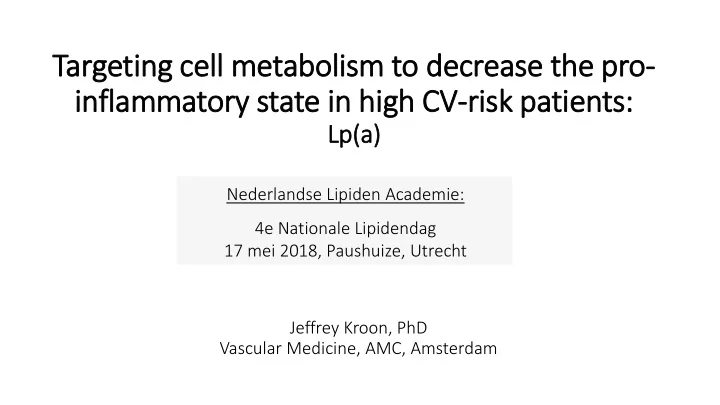

Targeting cell metabolism to decrease the pro- inflammatory state in high CV-risk patients: Lp Lp(a) Nederlandse Lipiden Academie: 4e Nationale Lipidendag 17 mei 2018, Paushuize, Utrecht Jeffrey Kroon, PhD Vascular Medicine, AMC, Amsterdam
Disclosures None
Lipids in cardiovascular disease • LDL-c lowering leads to reduction in CV events • However, not all events can be prevented by only LCL-c lowering • Not only lipids, but also inflammation plays a crucial role in disease progression Circulation 1999;99:736 – 743. Lancet 1995;345:1274 – 1275. N Engl J Med 1998;339:1349 – 1357. J Am Coll Cardiol 1999;33:125 – 130. N Engl J Med 1995;333:1301 – 1307. JAMA 1998;279:1615 – 1622. Lancet 2010;376:333 – 339.
Inflammation and atherosclerosis Atherosclerotic lesions are characterized by inflammation Surgeon J. Hudson, 1805 Discussion of inflammatory nature of atherosclerosis reopened in 1999, with first significant review: Cited > 28.000 times Ross, 1999. N Eng J Med.
Inflammation in the driver’s seat Atherosclerosis is characterized by chronic low grade inflammation - Arterial sites of disturbed laminar flow - Subendothelial accumulation lipoproteins - Inflammatory mø predominant cells CRP clinically useful as biomarker for risk prediction Libbey. Nature. 2002 Inhibiting inflammation the key to the future?
IL-1 b inhibition as target for atheroprotection Upstream of CRP → IL-1 b MI patients Ridker PM. Circ Res 2016;118:145-156. Antiinflammatory therapy targeting led to a significantly lower rate of recurrent cardiovascular events, independent of lipid-level lowering.
What if we go further upstream…? Induction of inflammation and production of inflammatory mediators costs energy Monocyte transendothelial migration Endothelial remodeling during migration Cytoskeleton (actin) endothelium Chemo/cytokines (e.g. IL-1 b ) Cytokine production, migration Lipids (Immuno)metabolism Inflammation
Immunometabolism Immunometabolism: The changes in intracellular metabolic pathways in immune cells that alter their function 3 major metabolic pathways involved: - Glycolysis - Tricarboxylic Acid (TCA) cycle - Fatty acid oxidation Complex interplay between metabolic reprogramming and immunity
Aerobic Respiration Glycoylsis 2 ATP Link reaction OXPHOS 30 ATP TCA cycle Kruiswijk et al. Nat Rev. Mol Cel Biol.2015
Different metabolic states during lifecycle Glut1 transports glucose into the cell Palmer. EBioMedicine, 2016
What they encounter determines “who” they becomes Can this be used in the clinic? Inflammatory Anti-inflammatory Glycolysis TCA/Oxphos
Lp(a) patients have increased vessel wall inflammation measured with 18F-FDG PET/CT-scan 18F-FDG PET/CT-scan Yellow = metabolic activity Van Der Valk et al. Circ 2016. 134(8):611-24 Increased glucose uptake in carotid and aorta (=increased glycolysis) What is the effect of this increased glycolysis?
Lp(a) patients have ‘pro - inflammatory’ monocytes Increased expression of - Chemokines - Adhesion markers CCR7 CCR7 CD CD29 Van Der Valk et al. Circ 2016. 134(8):611-24 Functional differences in monocyte behavior?
Lp(a) patients have ‘pro - migratory’ monocytes ex -vivo Hoog lp(a ) Laag lp(a ) Van Der Valk et al. Circ 2016. 134(8):611-24
Sub-conclusion: Lp(a) & Inflammation 1. 3. 2. 4. 1. Increased monocyte activation 2. Enhanced adhesion and transmigration across the endothelium 3. Increased production of pro-inflammatory cytokines Elevated inflammatory activity of the arterial wall (PET/CT) 4. Lp(a) Metabolism? inflammation Cytokine production, migration
Lp(a)-induced metabolic reprogramming individual with elevated Lp(a) levels blood withdrawal Lp(a) monocytes arterial endothelium Metabolic reprogramming
Lp(a) induces endothelial cell inflammation and monocyte migration Does this coincide with metabolic reprogramming? 100 mg/dL Lp(a) Kroon et al. Int. Rev. Cell. Mol. Biol. 2016 Rolling Migration Chemokine activation Firm adhesion Firm adhesion
Lp(a) induces endothelial cell metabolic reprogramming Green labeled glucose Inhibition? unstim. Lp(a) Migration Chemokine activation Firm adhesion Firm adhesion Glucose uptake Lactate production
Targeting cell metabolism decreases inflammation and migration 6 Transmigrated monocytes 5 (normalized) 4 3 2 Inhibition glycolysis 1 0 unstim. Lp(a) Lp(a) Unstim. Lp(a) Lp(a) Unstim. Lp(a) Lp(a) Unstim. Lp(a) Lp(a) + inhib + inhib + inhib Migration Firm adhesion
Clinical perspective of inhibition of inducible glycolysis • Selective inhibitor of inducible glycolysis: basal glycolytic rate not affected • Promising completed phase I trial Endothelial viability in cancer patients with various solid after 24h of inhibitor PFK-158 tumors. No side effects reported Possibly the new era of cardiovascular intervention
Acknowledgements Genetic Metabolic Diseases, AMC (Experimental) Vascular Medicine, AMC Riekelt Houtkooper Jan Schnitzler Michel van de Weeghel Julian Bachmann Miranda Versloot Renate Hoogeveen UCSD, San Diego, USA Bert Groen Sam Tsimikas Erik Stroes Joe Witztum Robarts Research Institute, Ontario, Canada Marlys Koschinsky
Recommend
More recommend